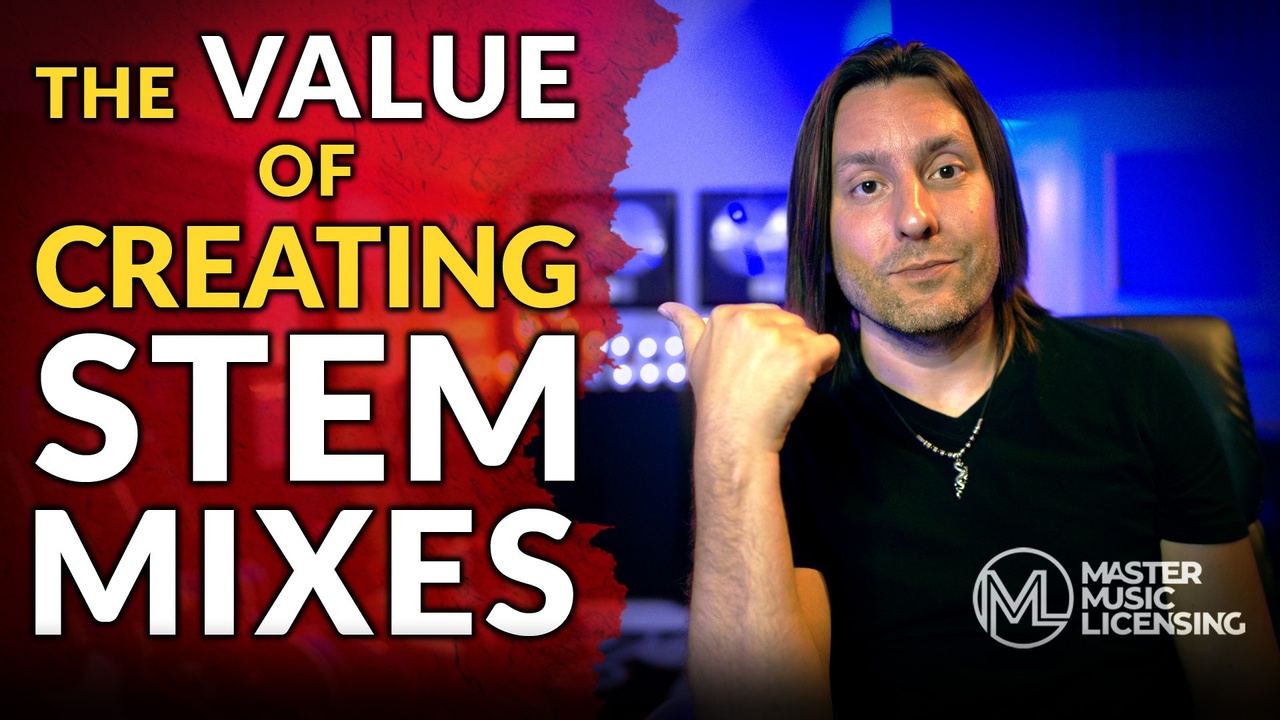
Every song is made up of individually recorded tracks. These can include drums, bass, guitars, keyboards, piano, orchestra, vocals, etc. A recording can include be as little as 1 or 2 audio tracks, and upwards of a hundred or more.
When the song is mixed, all those individual tracks are processed with EQ, Compression, Reverb, Delay, Panning, Volume Levels, Automation, and a litany of other effects that the mix engineer utilizes to create a cohesive blend between all the instruments. Those individual tracks are then recorded down to 1 stereo audio file. This is called the Master Mix, or Master, and it’s the final version of the song that is used to promote, and ultimately sell, the recording.
Stem Mixes are simply the stereo recordings of each specific instrument group that make up the Master Mix, and includes all the processing, levels, panning, etc.
Creating stem mixes is extremely easy, and is one of the elements discussed in the 4 Step Plan to Licensing Success that provides incredible value to your catalog.
From 12 To 2
Let’s start with the foundation of any song… the drums. Drums generally occupy between 8 to 12 (or more) audio tracks depending on the drummer’s setup, and how many microphones the engineer decides to use when recording the drum set. A snare drum, for example, can occupy 2 audio tracks when it is double mic’d; with a microphone on top picking up the actual attack of the drum, and a microphone on the bottom picking up the resonation of the snares. The same is true with the Kick Drum and Toms. Each of these tracks will then be uniquely processed in the mix.
Burning Stems
In order to create a drum stem, simply solo every drum, including all the processing (EQ, Compression, Reverb, etc), and record them to a stereo file.
Continue this process for every other instrument group.
It’s important to keep in mind that every Stem Mix from the song should start and end at the exact same locations. Even if one instrument group, for example, a Choir, only comes in during the last 30 seconds of the song, the Choir Stem will start at the same point as all the other instrument stems. It’s ok for there to be a few minutes of silence before the Choir comes in.
We do this because we want all the stem files to line up perfectly with each other.
Examples
Some examples of Stem Mixes include:
- Drum Stem
- Percussion Stem
- Bass Stem
- Guitar Stem
- Keyboard / Piano Stem
- Orchestra Stem
- Vocal Stem
- Choir Stem
It’s best to keep it simple and only deliver stems according to the respective instrument group.
Benefits of Delivering Stem Mixes
Stem mixes are important because they allow an editor, or re-recording mixer, the ability to quickly pull in all the audio files (they will line up perfectly because your start and end points are uniform throughout), and adjust the levels of individual instrument groups, without having to spend hours mixing or remixing the song.
Also, now a-days, many shows and films are mixed for 5.1 or 7.1 Surround. We mix music in only a stereo field (left and right), so providing stems gives the re-recording mixer complete control of how your track will sound within that surround field that he is mixing in.
As another example, let’s say your song is chosen for a national commercial. In that commercial, along with the music, there will be dialog as well as other sound design. By providing stems, you give the mixer the ability to quickly adjust the levels of your song according to what best suits the commercial’s needs. Maybe in one section they want to feature the vocal only, and in another they want to feature the drum and bass groove.
These stem mixes allow your end users the flexibility to accomplish their visual production goals, with minimal effort on their part.
Remember…
One thing to keep in mind is that your success, and your income, is determined by how many people you serve, and how well you serve them. Providing stems is yet another way to serve, and provide extraordinary value to, the end users of your music.
What are your experiences creating stem mixes? Share with us in the Comments Section below...
Want to Learn How to Successfully License Your Music to TV and FILM?
Want Your Songs to be Heard by Millions AND Generate a Consistent Income?
TRANSFORM from STARVING ARTIST to SUCCESSFUL MUSICIAN!

